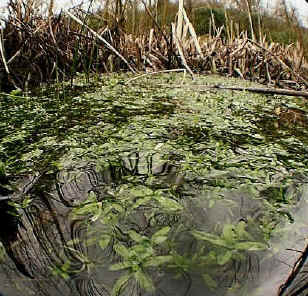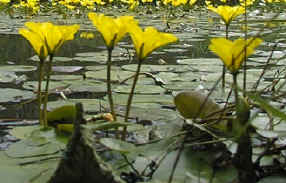Plant Adaptations to Aquatic Life
 |
Water Starwort in a marsh pool. |
Totally submerged plants are
the true water plants or hydrophytes. Because they are truly aquatic they have the
greatest number of adaptations to life in water. These include: Submerged plants lack the external protective tissues required by land plants to limit water loss. The epidermal (outermost) layer shows very little, if any, sign of cuticle formation. All the surface cells appear to be able to absorb water, nutrients and dissolved gases directly from the surrounding water. As a result, the internal system of tubes (xylem) which normally transports water from the roots to all parts of the plant is often greatly reduced, if not absent. Thus, if these plants are removed from the water, they wilt very quickly, even if the cut stems are placed in water. This is because the normal water transport system is poorly developed. As might be expected, there are also no stomata (breathing pores) on the leaves. Roots, which normally play a very important role in the absorption of nutrients and water from the substrate, are often also reduced and their main function is anchorage. The root hairs which function in absorption are often absent and roots themselves may be entirely dispensed with (e.g. Bladderwort). Many species have very specialised leaf shapes. The submerged leaves are often highly dissected or divided. This has the advantage of creating a very large surface area for absorption and photosynthesis. It also minimises water resistance and hence potential damage to the leaves. Heterophylly, where leaves of different shapes are produced depending on where on the plant they are, is common. This can create great problems for identification! In many cases, the submerged leaves are totally different to floating or emergent leaves on the same plant. The emergent leaves are usually much less divided, if not entire and have a more similar internal structure to those of land plants. Air-filled cavities often extend throughout the leaves and stems of aquatic plants, providing an internal atmosphere. Certain aquatic fly and beetle larvae have a novel adaptation which allows them to take unusual advantage of this. A sharp appendage on the end of their abdomen is used to pierce into submerged plants, giving them access to the internal air-filled cavities as their own personal oxygen source. Offwell Wetland Open Water Species List
Floating plants are of two types: those which are rooted with floating leaves (e.g. Water Lily) and those which are not rooted in the sediment, but just float on the surface (e.g. Duckweed). Floating leaves are generally tough because they have to withstand the weather and water movement. The green pigment-containing chloroplasts important for photosynthesis are restricted to the upper surface of the leaves which are the only surface to be well lit. Stomata (breathing pores), through which gas exchange takes place in the leaf, are also found only on the upper surface of the leaf. This upper surface often has a thick waxy cuticle to repel water and help to keep the stomata open and clear. Air-filled internal cavities are also often present. Terrestrial plants such as trees have to develop an enormous quantity of structural material in order to rise above all the other plants and collect the lion's share of the light available. Water lilies provide a neat example of a plant which has managed to do exactly the same thing, but with the minimum of structural material. Weak stems produce a massive floating canopy of leaves which dominate the local aquatic plant community just as effectively as trees dominate in a woodland. The difference lies in their external medium. Water provides all the necessary support, whereas air does not. Adaptations
of terrestrial plants
These are emergent plants with the lower parts often submerged. They are typically, tall narrow-leaved plants, which offer little resistance to fluctuating water levels or high winds. They are therefore less likely to be damaged. Their height means that they are unlikely to ever be completely submerged during flooding. The stems have tough internal fibres and a hollow structure. This allows them to withstand severe winds without damage. Reedmace (above) has noticeably narrow aerofoil shaped leaves, presumably for this reason. |
Offwell Wetland Swamp Species List
Plant zonation in
wetlands
Continue

